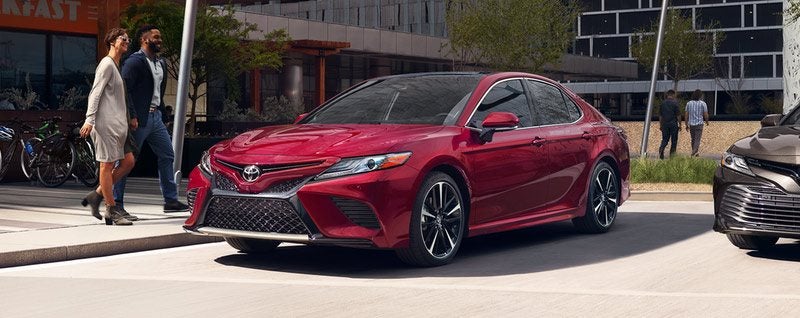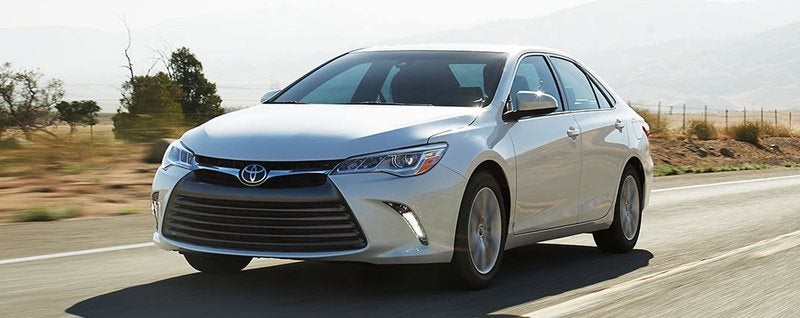- Value your trade and get an instant offer for your car in minutes.
- Click Here
Compare 2018 Toyota Camry vs 2017 Toyota Camry


2018 Toyota Camry
|
Engine: |
2.5-Liter 4-Cylinder DOHC |
|
Horsepower: |
203 hp @ 6600 rpm |
|
Torque: |
184 lb.-ft. @ 5000 rpm |
|
Fuel Economy: |
29 city / 41 hwy mpg * |
|
Transmission: |
8-speed Electronically Controlled automatic Transmission (ECT-i) |
2017 Toyota Camry
|
Engine: |
2.5-Liter 4-Cylinder DOHC |
|
Horsepower: |
178 hp @ 6000 rpm |
|
Torque: |
170 lb.-ft. @ 4100 rpm |
|
Fuel Economy: |
24 city / 33 hwy mpg * |
|
Transmission: |
6-speed Electronically Controlled Transmission (ECT-i) |
2018 Toyota Camry vs 2017 Toyota Camry
Serving Suitland, MD, Alexandria, VA, and Washington, DC
Midsize sedans supply roomy accommodations for both commuters and their cargo while keeping mileage to a reasonable level. The Toyota Camry has achieved these goals so well that it's become the top selling car of any sort in the US for 15 years now thanks to the 2017 model year. To see if the 2018 Camry can continue this legacy, check out the comparison below.
Performance
The 2017 Camry offers buyers a 2.5 liter 4-cylinder block that balances gas savings with muscle by achieving 178 horsepower while keeping fuel consumption to 24 mpg city and 33 mpg highway. For more oomph, a 3.5 liter V6 generates 268 horsepower with fuel usage held to 21 mpg city and 30 mpg highway. Both engines are paired with a 6-speed automatic transmission. The 2018 Camry advances brawn and fuel conservation by trading the 6-speed transmission with an 8-speed automatic transmission along with some engine redesigns. The results are a 2.5 liter 4-cylinder that creates 203 horsepower with 28 mpg city and 39 mpg highway and a 3.5 liter V6 cranking out 301 horsepower with 22 mpg city and 33 mpg highway. The 2018 Camry appears to have a clear lead here, but its 2017 predecessor has the up-front price advantage as the older model.
Appearance
Car shoppers definitely have a choice in these two model years when it comes to looks. Just the overall shape of the Camry has changed in 2018 with the vehicle sitting lower to the ground. Ground clearance has dropped from 6.1 inches to 5.7 inches and height has been lowered from 57.9 inches to 56.9 inches. To be sure, this comes without any noticeable difference in passenger roominess. For those preferring high-profile seating, the 2017 Camry is the way to go while those who enjoy a low, race car style will appreciate the 2018 update. The changes continue with a new front grille design that replaces the wide, rounded grille of the 2017 Camry that fans out at the bottom with a smaller grille that?s horizontally indented to vaguely give the silhouette of a bird with wings outstretched. Inside, the 2018 makeover raises the height of the center console armrest and positions dashboard controls and displays in a less symmetrical, more curvilinear fashion.
Safety
The big advantage of the 2017 Camry in this category is the fact that it's been thoroughly tested by both the NHTSA and the IIHS and been given the highest marks for overall safety. The 2018 model hasn't been tested to date, but given Toyota's reputation, it's all but given that it'll match its predecessor. Otherwise, both versions offer antilock brakes, airbags, traction and stability control, and a rearview camera. High tech features like front impact alert with automatic braking, lane departure warning, blind spot monitoring, and rear cross-traffic alert can be found as options on the 2017 Toyota Camry while the 2018 successor makes the forward collision and lane departure alert features standard on all models.
It's obvious that the 2018 Camry has made itself distinct from the 2017 Camry. It's also obvious that this latest edition maintains the Camry tradition of high standards. To see what both model years have to offer, try them both out at our dealership today.
* 2018 EPA-estimated mileage. Actual mileage will vary.
2017 EPA-estimated mileage. Actual mileage will vary.


